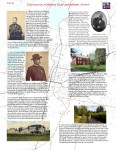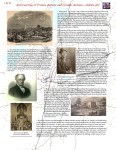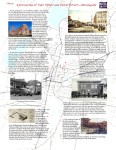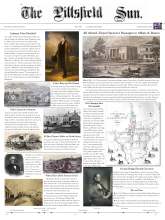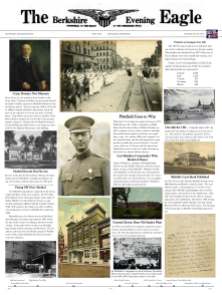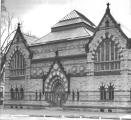Several times a week, in all weather, I drive to Pittsfield State Forest to hike the varied paths there. On my way, I pass over Pecks Road, then Dan Casey Memorial Drive before turning on to Churchill Road. Almost every time, I wonder who Dan Casey was or who was this Churchill? Could it be the Prime Minister of England?
I knew about Peck, since Jabez Peck ran two textile mills on this road, for over 50 years. It turns out Churchill is named after John Churchill, a captain in the Revolutionary War, who bought land for a farm on what is now state forest. Dan Casey was a city councilor who lived up on Hancock Road and loved fishing. He advocated for a causeway to be built over Onota Lake, and when he passed away, the council named the road for him.
These were just a few of the gleanings of Pittsfield history that emerged from research for the virtual exhibit, “What’s in a Name?” The Berkshire County Historical Society sponsored this exhibit for the annual 10×10 Upstreet Arts Festival put on by the city each February. You can find the 10 panels of the exhibit here: What’s in a Name? The Streets of Pittsfield. (Special thanks need to go out to Chris Laney at Berkshire Community College and the Local History Department at the Berkshire Athenaeum for their assistance.)
Many streets have nothing to do with historical figures, named after the children of the construction developers, or trees, flowers and seasons, and even directions and numbers. But, others do tell a story of Pittsfield. As might be expected, there’s a heavy emphasis on business and industry, given the city’s long history of manufacturing. Street names such as Pomeroy and Kellogg and Stanley and Dan Fox span the centuries of Pittsfield’s business evolution.
Likewise, it would be no surprise that the town’s founders (Wendell, Crofut, or Merrill) would grace the street signs or that the military heroes, such as Easton, Brown or Williams should be recognized. For others, like Colt, Melville and Allen, members of the same family are honored.
What comes through, though, is another truth about the history of the city. No women or people of color are recognized.
What does that absence tell us? For one thing, for many years, only white men could own property, could vote and run for office, by law. Even when the laws changed, women and people of color did not enter the ranks of business ownership or politics, by discrimination.
Yet, there are streets named after directors of schools (Tyler and Dewey), but not Clara Wells or Mildred Hall who opened girls’ schools in the 1800s. Or, William Plunkett, a director of the Berkshire Athenaeum, gets a street but not Amy Miller, who was president of the same library and founder of Hancock Shaker Village. Samuel Harrison clearly served the city and the nation, as the first minister of the Second Congregational Church, and, as chaplain for the all-Black Massachusetts 54th regiment in the Civil War, he fought for and won equal pay for Black soldiers.
It’s inconvenient to change street names, especially for people whose homes are on that street and have to change postal addresses. But, it’s been done in the past, as there were numbered streets on the west side of North Street where Robbins (shoe factory), Dewey (education), and Center Street are now located. One developer who built houses on Kremlin Street was even able to get that street named to Lillian when he thought no one would want to live on a street linked to communism.
Given the moment of national reckoning we are in, moving to make corrections of the local record is a small, but important step and worth the inconvenience.
This post first appeared in The Berkshire Eagle, February 27, 2020.
















